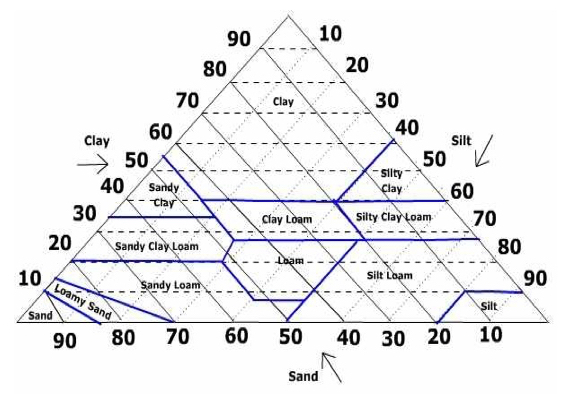So far on our investigation into soil texture we’ve discussed the problems of building sand castles, why you shouldn’t let the Treasurer buy sand for you and a few other less important details like the complexity of sand, soil formation, particle size distribution, macro and micro soil porosity and we finished last time by looking at the famous Soil Texture Triangle. Here it is again:
The Soil Texture Triangle can look a bit off putting at first, but if you stick with me for a minute I’ll try to explain it.
The Soil Texture Triangle is a tool we can use to help define what type of soil we have. The ideal bowling green soil (rootzone) I described in part 1 of this series falls into the category Sandy Loam. Let’s see how that would look on the Texture Triangle.
The triangle gives names to various combinations of clay, sand, and silt. First of all, look at each of the 3 sides of the triangle. There’s one side to represent Sand (base of the triangle) and one side each for Silt and Clay, so we’ve covered the 3 mineral components of all soils. Now look at the numbers that are arranged symmetrically around the perimeter of the triangle. These correspond with the percentages of Clay (left), Silt (right) and Sand (base).
Now look for the arrow beside each mineral element. You will notice that each arrow points in a particular direction and that there are hatched lines within the triangle which run in the direction of the arrow.
When you have the percentages (by weight) of each mineral component of your soil sample, you can find the percentage for each component on the relevant side of the triangle and trace these into the interior following the direction of each of the arrows. To classify a soil sample, you find the intersection of the three lines that correspond with the proportions of your soil components. The triangle is divided up into eleven soil texture types by thick blue lines, making it easy to define your soil type.
Surprises
The Soil Texture Triangle throws up a few surprises. Firstly, a soil with just 21% Clay is basically still classified as a Sandy Clay Loam indicating that it is very clayey. Even if it contains upwards of 50% sand.
A soil with just 75% sand and 15% clay is a Loamy Sand, meaning that it is predominantly sandy in nature.
Regardless of the final 10%, a soil with 90% sand is considered just Sand. Many bowling clubs have added so much sand over the years through top-dressing that they are now trying to manage a rootzone that is classified as sand
PSD Testing
These surprises crop up for one main reason; samples are classified by percentage in terms of weight and not volume. In a later article I will go into a bit more detail on this…it’s important!
Particle Size Distribution tests are carried out in a soil lab using expensive, but really quite simple equipment. I have often set up make shift soil labs on golf course construction projects in order to monitor the quality of sands and rootzone materials being delivered to the site before they are used in the construction process.
PSD testing involves taking a small sample of a soil, drying it out completely and then shaking it through a series of graduate sieves before weighing the results from each sieve. The results can be easily converted to a percentage by weight which can then be translated into a PSD chart and the soil located on the Triangle we looked at above.
Here’s a video that shows the process:
The Sand Craze
In relatively recent times, say from the 1970’s onwards, greenkeepers, bowls clubs and golf clubs have become more than a little obsessed with sand. It’s true that some of the best greens are very sandy in their construction, but their success is due to more than just sandy-ness. As mentioned, the ideal rootzone of a bowling green is a Sandy Loam and the Triangle reminds us that the sand content of this could be anywhere between 55 and 85%. A suitable smooth, fast and consistent green can certainly be achieved with a maximum of 70% sand in the original mix. Please remember that we are only talking about the Mineral component of the soil at this stage and that sand varies widely.
The trouble with the promotion of high sand rootzones comes when people get it into their heads that if sand is good, then more sand must be better. A very high proportion of the greens built in the UK over the last 200 years would have started with 150-200mm (6-8inch) deep rootzones made up of local soil, rocks n all. The approach to improving these greens would quite rightly have included regular top-dressing with a sandy top-dressing. In recent times (1970’s onwards) we have seen a huge increase in the sand applied to greens in an attempt to improve them. Once a workable rootzone has been achieved, the relentless adding of sand every year must stop and for a very large number of clubs in the UK and further afield that time passed many years ago. Every ounce of sand added now is taking these greens further towards the extreme left side of the Soil Texture Triangle and is making greens unmanageable. They are inert, lacking soil microlife and stuffed full of hydrophobic sand that restricts moisture and nutrient availability.
The end of the 4 part trilogy?
This was supposed to be a trilogy, but now that it’s reached 4 parts, why not go the whole hog and add a 5th? In this series we’ve looked at a subject that is at the very core of good greenkeeping and the key to a Performance Bowling Green; Soil Texture. In the 5th and final part of this trilogy we’ll look at Sand Top Dressing.
Please leave a comment and/or questions below:

